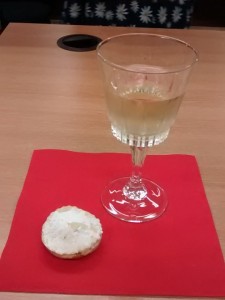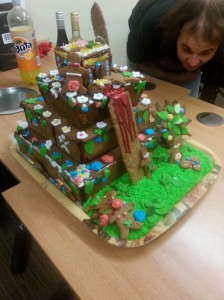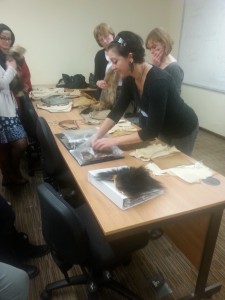Last night we had our Student Seminar (PGtips) Christmas Party! PGtips happens once every three weeks or so; it’s a chance for PhD and Masters students to give short presentations on their research and to get feedback and new ideas from the postgraduates in the department. It’s a great way for the Exeter Archaeology Postgrads to keep at the cutting edge of research, and it’s an important social gathering as well, supported by wine and baked goods courtesy of its attendees. This week we broke into the Prosecco reserves! As PGtips convenor/organiser/sommelier it is my responsibility to make sure there are people to present and chilled wine to drink each session, which is why as of Tuesday afternoon four lovely bottles of Prosecco were in the milk fridge – mercifully they were left alone by Tea Club members! I also bake each week, and our Christmas party was no exception – on Wednesday night I made more than 50 mince pies!
However, my own intrepid baking paled in comparison to the now annual, near legendary gingerbread assembly skills of Tine Schenck who, partnered with Malene Lauritsen, successfully made (I should really say built) an Andean pyramid temple out of gingerbread. This monstrous construction was complete with sacrificial altar, decapitated victims and highly decorated priests. As is wont to happen when presented with such a feat of hard work people were loathe to break into the structure to eat it, until Matt Knight, whose PhD is all about destruction, picked up a nearby hammerstone and exuberantly sped up the taphonomic process.
As we all nibbled on bits of masonry, tree and gingerbread sacrifice we listened to two brilliant talks. The first was Regina Gonda on Creating landscapes: Pre-Columbian land use and its modern legacy in the Purus-Madeira interfluve, Central Amazon. She introduced her PhD topic and showed us amazing photos from her recent fieldwork in Amazonia to collect soil samples for phytolith analysis. This was followed by Theresa Kamper, whose presentation Which Rub Made the Rug: differentiating tanning technologies in prehistory was on her recently passed PhD project on creating a comparable reference collection to help identify tanned material in archaeological contexts. Of course this culminated with a show/stroke and tell of her collection, which includes some really fascinating species and items of clothing. Thanks to both of our speakers, our bakers, our wine provider and all the people who came along – I hope people are surviving Post-Prosecco-ral Archaeology this morning!
Written by Emily Johnson, who runs the PGtips Student Seminar Series.



